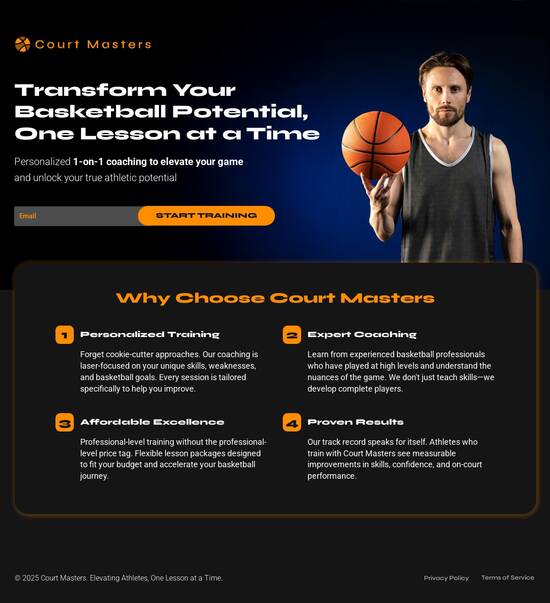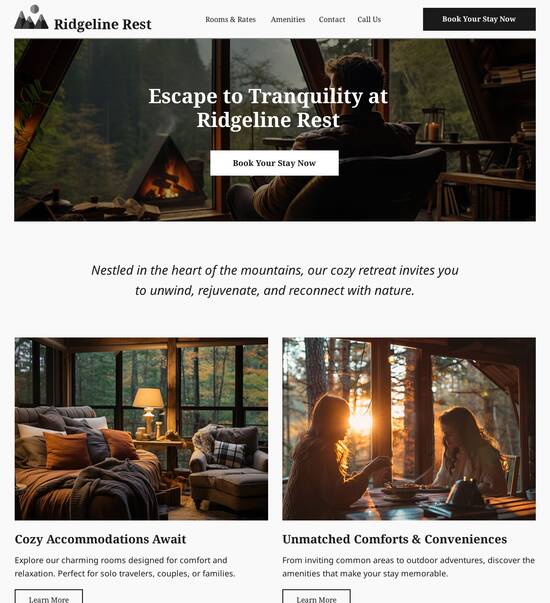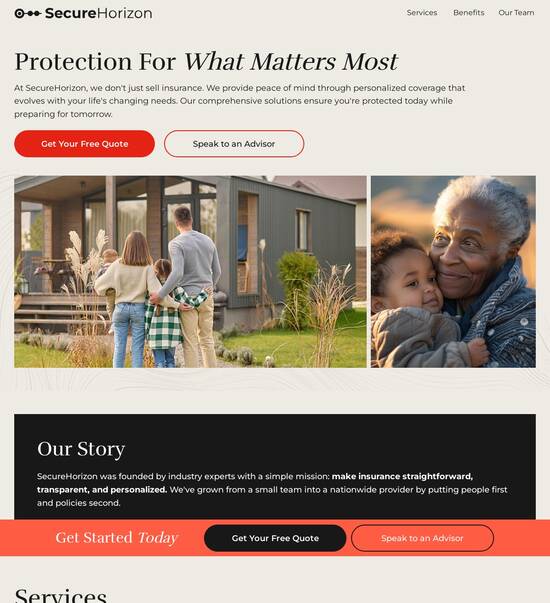
Thank you page template for React.js developers
Explore Similar TemplatesAbout template
Master your online marketing with this builder for thank you page template for React.js developers. Try more tools to create an immaculate landing page.
Recommended templates

Easy to build without coding
With the intuitive drag-and-drop builder, anyone on your team can create high-converting pages without any knowledge of code or design. Make enhancements to your landing page with custom widgets using Javascript, HTML/CSS, or third-party scripts.

Multiple layouts for any industry and goal
Select from 500+ landing page layouts built to boost conversions across industry-specific scenarios. Customize them by adjusting fonts, adding images, and generating on-brand content with the AI assistant. Quickly scale with Instablocks® and Global Blocks that you can save, reuse, and update globally.

Loads fast and looks polished on any device
Every template is responsive, which means they present professionally on any device and load blazingly fast with our Thor Render Engine. You can also power them up with Google AMP technology to deliver an unparalleled mobile experience and drive higher conversions.

Robust analytics & experimentation
Get real-time updates and reporting across all your devices, showing the number of visitors, conversions, cost-per-visitor, and cost-per-lead. Launch AI-powered experiments, run A/B tests, and use heatmaps to analyze user behavior, then optimize your landing page to maximize conversions.







Easy to build without coding
With the intuitive drag-and-drop builder, anyone on your team can create high-converting pages without any knowledge of code or design. Make enhancements to your landing page with custom widgets using Javascript, HTML/CSS, or third-party scripts.
Multiple layouts for any industry and goal
Select from 500+ landing page layouts built to boost conversions across industry-specific scenarios. Customize them by adjusting fonts, adding images, and generating on-brand content with the AI assistant. Quickly scale with Instablocks® and Global Blocks that you can save, reuse, and update globally.
Loads fast and looks polished on any device
Every template is responsive, which means they present professionally on any device and load blazingly fast with our Thor Render Engine.
Robust analytics & experimentation
Get real-time updates and reporting across all your devices, showing the number of visitors, conversions, cost-per-visitor, and cost-per-lead. Launch AI-powered experiments, run A/B tests, and use heatmaps to analyze user behavior, then optimize your landing page to maximize conversions.
All the features you need to build lead-generating landing pages
Explore more featuresLearn how to build top-performing landing pages for any goal
FAQs
Leading the way in building high-performing landing pages





An effective landing page for digital marketing campaigns
Creating a powerful landing page is crucial for enhancing your digital marketing results. Instapage offers an intuitive platform tailored for marketers, helping you to optimize and maximize ROI efficiently. With a focus on different sectors including business services and education, you can tailor your campaigns to your audience's needs.
Understanding the importance of landing pages
Landing pages serve as dedicated spaces for specific campaigns. They are designed to capture leads, drive conversions, and provide a seamless user experience. Here are some essential aspects to consider for creating impactful landing pages:
- Clear Call-to-Action (CTA): Make sure your CTA stands out and guides users towards the next step, such as signing up or making a purchase.
- Focused Content: Limit distractions by presenting clear and concise information that directly relates to the user's needs and motivations.
- Mobile Optimization: With a significant amount of traffic coming from mobile devices, ensuring your landing pages are responsive is essential.
Step 1: Select a high-converting template
Start your campaign by choosing a visually appealing and conversion-focused template from Instapage's library. Here’s how to effectively leverage these templates:
Step 2: Customize with dynamic elements
Utilize Instapage’s intuitive builders to adjust the template to fit your branding and messaging. Consider these elements:
- Dynamic Text Replacement: Personalize your landing page content to match the keywords users searched for, increasing engagement.
- AdMaps: Align your advertising strategies seamlessly with your landing pages, ensuring your audience receives a tailored experience.
- Heatmaps: Understand user behavior to adjust areas of your landing pages for better performance.
Step 3: Optimize and analyze
Continually optimize your landing page using A/B testing and analytics tools available in Instapage. This is crucial for long-term success, as it allows you to understand what works best for your audience.
- A/B Testing Features: Test different headlines, layouts, and CTAs to discover which combinations yield the highest conversion rates.
- Performance Analytics: Use data-driven insights to track metrics like visitor behavior and conversion rates, adjusting campaigns as necessary.
- Feedback Mechanisms: Incorporate user feedback to enhance usability and address any friction points users may encounter.
In conclusion, by leveraging Instapage’s powerful tools, you can build effective landing pages that drive your digital marketing success.
Engage with your audience better and increase your campaign's effectiveness by starting your journey with Instapage today!
Thank you page template for ReactJS developers
Understanding the thank you page: Importance for ReactJS developers
A thank you page is more than just a simple acknowledgment. It serves as an important element in the user experience, especially for ReactJS developers. This page comes into play post-action, such as a form submission or purchase, providing users reassurance that their action was successful. The significance of the thank you page extends into the conversion funnel, reinforcing brand trust and satisfaction. By enhancing user satisfaction and retention, developers can turn a simple page into a conversion tool that promotes further engagement.
Acknowledges user actions and provides closure.
Encourages users to explore additional content or products.
Can integrate social sharing options, enabling users to promote their positive experience.
Key components of a thank you page template
An effective thank you page should contain essential elements that provide further guidance to users while maintaining a visually appealing structure. Key components include a clear acknowledgment message, providing users with reassurance after their action. Additionally, offering next steps or suggestions—like subscribing to a newsletter or exploring related products—helps guide users through their journey. Visual design elements such as colors and typography play an essential role in creating a consistent brand image on the thank you page.
Organizing the structure is crucial for a clear layout. A header can showcase branding and include navigational links. Meanwhile, a sidebar may contain additional resources such as blogs or related content links. Finally, a footer should provide contact information and links to social media platforms, enhancing accessibility and encouraging user engagement.
Building a thank you page using ReactJS
Setting up your project in ReactJS for a thank you page template is a straightforward process that requires installation of necessary dependencies. Start by creating your React app with Create React App, which simplifies the initial setup. After initializing the project with a command in your terminal, make sure to install React Router to handle navigation effectively.
Use 'npx create-react-app your-app-name' to create a new React app.
Navigate into your app directory with 'cd your-app-name'.
Install React Router with 'npm install react-router-dom' for routing.
Creating the thank you page component will involve understanding how to manage routes with a `routes.jsx` file. This will allow you to direct users to the thank you page after they complete an action. Within the component code, structuring the JSX to include all essential elements is vital. For styling, you can choose between CSS Modules or styled-components for modular and reusable styles. Ensure responsiveness is a priority, adapting designs to suit various device sizes.
Crafting engaging content for thank you pages
Personalization can significantly enhance the user experience on your thank you page. Techniques such as addressing users by name or tailoring messages based on user actions help create a more individual experience. Additionally, leveraging user data allows developers to deliver targeted content, making users feel their interactions are recognized and valued. This connection encourages repeat engagement, fostering customer loyalty.
Incorporating interactive elements such as buttons and forms can further improve engagement. Consider adding animations and transitions that greet users or highlight calls to action, ensuring the page feels lively rather than static. Tools like sliders or carousels can be used to display related offers or testimonials, keeping users engaged and encouraging them to explore more content.
Collecting user feedback on your thank you page
Gathering user insights is essential for improving the overall experience. Encouraging feedback on your thank you page not only shows that you value user opinions, but it also provides actionable insights. Designing feedback forms should adhere to best practices: keeping them concise, asking relevant questions, and ensuring an easy submission process. This can enhance the likelihood of user participation.
Integrating third-party tools can allow for more comprehensive feedback collection. Tools like Typeform or Google Forms can be embedded directly into your thank you page. These tools not only provide a seamless way to gather opinions but also enable the analysis of the collected data, ensuring continuous improvement of user engagement strategies.
Integrating APIs and data management
A robust thank you page can benefit from integration with REST APIs to update content dynamically. Using API calls can ensure that the page reflects real-time information, such as order confirmation details or personalized messages based on user data. This level of customization is critical for enhancing user experience and making users feel more connected to your application.
In addition to updating content, managing user interactions and preferences through API calls is essential for maintaining a sustainable relationship with users. Being compliant with regulations like GDPR ensures user data security and builds deeper trust. As your application scales, consider leveraging library packages like Axios or Fetch to streamline API requests in your React components.
Analytics and performance tracking
Tracking user behavior on your thank you page is vital for understanding engagement levels. Using Google Analytics can provide insights into how users interact with the page, including the time spent and actions taken afterward. Key metrics such as bounce rate and conversion rate are also crucial for evaluating the effectiveness of your thank you page. Understanding these metrics will allow you to make data-driven decisions for improvement.
Monitor key user interactions, such as clicks on suggested products.
Analyze traffic patterns to tailor content further.
Set up goals within Google Analytics to track specific actions post-action.
Additionally, utilizing A/B testing tools can help refine the thank you page design and content. By experimenting with different layouts and messages, you can pinpoint which versions resonate most with users, ultimately optimizing for higher conversion rates.
Sharing best practices with developer communities
Engaging with the developer community is vital for continuous improvement and knowledge sharing. Platforms like GitHub allow ReactJS developers to share their thank you page templates, fostering collaboration and innovation. Engaging in React-specific forums, such as Reddit’s React community or Stack Overflow, can provide valuable insights into best practices and troubleshooting advice when building your template.
Learning from peer-developed templates and case studies can inspire fresh ideas and improvements. By reviewing others' work, you can identify strategies that worked well, allowing you to curate a thank you page that reflects both industry standards and unique brand identity.
Building a collaborative team environment
For successful implementation, fostering a collaborative environment within your team is essential. Strategies for brainstorming sessions can facilitate an open exchange of ideas, allowing each team member to contribute their expertise toward the thank you page design. Encouraging diverse inputs can spark creativity, ensuring that different perspectives are incorporated into the template.
Utilizing project management tools like Trello or Asana can help streamline workflows and maintain organization during the development process. By keeping track of tasks and deadlines, teams can ensure that everyone is aligned and that the project progresses smoothly, ultimately resulting in a more polished and effective thank you page.
Improving navigation with routes and links
Optimizing navigation within your React application is essential, especially from your thank you page to other parts of the website. Implementing routing best practices can enhance user experience, guiding users seamlessly from completion to further engagement. Including breadcrumbs or clear links can help users understand where they are and what actions they can take next.
Create intuitive pathways back to content users may want to explore after completing an action.
Utilize React Router to set up clean and manageable routes.
Test user navigation flows to ensure the journey is straightforward.
Ensuring accessibility compliance
Accessibility is an essential aspect of web development that should not be overlooked in your thank you page design. Ensuring compliance with web content accessibility guidelines (WCAG) makes your content available to a wider audience, including those with disabilities. This involves creating pages that can be easily navigated by keyboard, screen readers, and other assistive technologies.
Use semantic HTML elements and proper markup to support screen readers.
Incorporate sufficient color contrast between text and background.
Provide text alternatives for visual content.
Testing tools like Axe or WAVE can help ensure your thank you page adheres to accessibility guidelines. Regular reviews and updates in line with these guidelines can create a more inclusive web experience.
Highlighting successful implementations
Showcasing successful implementations of thank you pages can offer actionable insights. Analyzing how innovative designs have positively impacted user metrics can inform your development process. Highlighting these case studies allows you to learn from others' experiences, combining effective strategies to growth.
Explore examples that include user engagement metrics before and after the implementation.
Present diverse thank you page templates to inspire creativity.
Discuss key takeaways and lessons learned from each implementation.
Adopting best practices in template design
When designing your thank you page template, being aware of common pitfalls is essential. Avoid cluttering the page with too much information, as it can overwhelm users after an action. Instead, focus on clear messaging and inviting visual designs that encourage users to engage and explore further.
Ensure the page loads quickly without unnecessary delays.
Prioritize showcasing compelling next steps to maintain interest.
Regularly test the page for both functionality and user acceptance.
Keeping up with future trends in thank you page development can also provide ideas for innovation. Staying informed on design trends and evolving user expectations will allow you to keep your pages fresh and effective.
Ready to skyrocket conversions?
Supercharge your ad campaigns with high-performing landing pages
Get started














